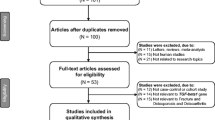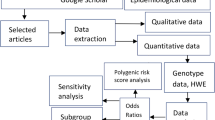Abstract
Osteoporotic fractures are some of the major causes of morbidity and health care expenditure among the elderly. Identifying subjects at risk could be of major importance since several preventive treatments are now available. A large genetic component in the development of osteoporosis has been established. Previous studies concerning association of the common point mutation C677T in methylentetrahydrofolate reductase (MTHFR) and osteoporosis have revealed contradictory results. The aim of this study was to test the association between the MTHFR polymorphism, homocysteine, and fractures in a population-based sample of Danish twins aged 73+. In total, 689 subjects, with a mean age of 78 years, participated. Genotype and data of fractures are available from 687 subjects—144 with a previously diagnosed fracture. The genotype distribution is as follows: CC, CT, and TT genotypes, 317 (46.1%), 298 (43.3%), and 73 (10.6%), respectively. Using the proportional odds-ratio model adjusted for age, gender, and body mass Index, the odds-ratio of fracture was 1.5 per number of T alleles—meaning that fracture risk is 1.5 times higher in the CT group compared with the CC group and again 1.5 times higher in the TT group compared with the CT group. Homocysteine, smoking, and self-reported hormone use provided no significant contribution to fracture risk. Using biometrical modelling, the heritability of the liability to fractures was found to be approximately 0.10, when the effect of the MTHFR locus was included, and 0.07 when it was omitted. But both confidence intervals include zero and the estimates are therefore not significant. In conclusion, we here provide evidence for a significant impact of the MTHFR genotype on the occurrence of fractures in an elderly Danish population.
Similar content being viewed by others
References
Cummings SR, Melton LJ (2002) Epidemiology and outcomes of osteoporotic fractures. Lancet 359:1761–1767
(2000) Osteoporosis prevention, diagnosis, and therapy. NIH Consens Statement 17:1–45
Nguyen TV, Center JR, Sambrook PN, Eisman JA (2001) Risk factors for proximal humerus, forearm, and wrist fractures in elderly men and women: the Dubbo Osteoporosis Epidemiology Study. Am J Epidemiol 153:587–595
Klotzbuecher CM, Ross PD, Landsman PB, Abbott TA III, Berger M (2000) Patients with prior fractures have an increased risk of future fractures: a summary of the literature and statistical synthesis. J Bone Miner Res 15:721–739
Seeman E, Hopper JL, Bach LA, Cooper ME, Parkinson E, McKay J, Jerums G (1989) Reduced bone mass in daughters of women with osteoporosis. N Engl J Med 320:554–558
Pocock NA, Eisman JA, Hopper JL, Yeates MG, Sambrook PN, Eberl S (1987) Genetic determinants of bone mass in adults. A twin study. J Clin Invest 80:706–710
Morrison NA, Qi JC, Tokita A, Kelly PJ, Crofts L, Nguyen TV, Sambrook PN, Eisman JA (1994) Prediction of bone density from vitamin D receptor alleles. Nature 367:284–287
Kobayashi N, Fujino T, Shirogane T, Furuta I, Kobamatsu Y, Yaegashi M, Sakuragi N, Fujimoto S (2002) Estrogen receptor alpha polymorphism as a genetic marker for bone loss, vertebral fractures and susceptibility to estrogen. Maturitas 41:193–201
Shiraki M, Shiraki Y, Aoki C, Hosoi T, Inoue S, Kaneki M, Ouchi Y (1997) Association of bone mineral density with apolipoprotein E phenotype. J Bone Miner Res 12:1438–1445
Langdahl BL, Knudsen JY, Jensen HK, Gregersen N, Eriksen EF (1997) A sequence variation: 713-8delC in the transforming growth factor-beta 1 gene has higher prevalence in osteoporotic women than in normal women and is associated with very low bone mass in osteoporotic women and increased bone turnover in both osteoporotic and normal women. Bone 20:289–294
Devoto M, Specchia C, Li HH, Caminis J, Tenenhouse A, Rodriguez H, Spotila LD (2001) Variance component linkage analysis indicates a QTL for femoral neck bone mineral density on chromosome 1p36. Hum Mol Genet 10:2447–2452
Karasik D, Myers RH, Hannan MT, Gagnon D, McLean RR, Cupples LA, Kiel DP (2002) Mapping of quantitative ultrasound of the calcaneus bone to chromosome 1 by genome-wide linkage analysis. Osteoporos Int 13:796–802
Klerk M, Verhoef P, Clarke R, Blom HJ, Kok FJ, Schouten EG (2002) MTHFR 677C-->T polymorphism and risk of coronary heart disease: a meta-analysis. J Am Med Assoc 288:2023–2031
Kelly PJ, Rosand J, Kistler JP, Shih VE, Silveira S, Plomaritoglou A, Furie KL (2002) Homocysteine, MTHFR 677C-->T polymorphism, and risk of ischemic stroke: results of a meta-analysis. Neurology 59:529–536
Frosst P, Blom H, Milos R, Goyette P, Sheppard C, Matthews R, Boers G, den Heijer M, Kluijtmans L, van den Heuvel L, Rozen R (1995) A candidate genetic risk factor for vascular disease: a common mutation in methylenetetrahydrofolate reductase. Nature Genet 10:111–113
Goyette P, Christensen B, Rosenblatt DS, Rozen R (1996) Severe and mild mutations in cis for the methylenetetrahydrofolate reductase (MTHFR) gene, and description of five novel mutations in MTHFR. Am J Hum Genet 59:1268–1275
Miyao M, Morita H, Hosoi T, Kurihara H, Inoue S, Hoshino S, Shiraki M, Yazaki Y, Ouchi Y (2000) Association of methylentetrahydrofolate reductase (MTHFR) polymorphism with bone mineral density in postmenopausal Japanese women. Calcif Tissue Int 66:190–194
Jørgensen HL, Madsen JS, Madsen B, Saleh MM, Abrahamsen B, Fenger M, Lauritzen JB (2002) Association of a common allelic polymorphism (C677T) in the methylene tetrahydrofolate reductase gene with a reduced risk of osteoporotic fractures. A case control study in Danish postmenopausal women. Calcif Tissue Int 75:386–392
Abrahamsen B, Madsen JS, Tofteng CL, Stilgren L, Bladbjerg EM, Kristensen SR, Brixen K, Mosekilde L (2003) A common methylentetrahydrofolate reductase (C677T) polymorphism is associated with low bone mineral density and increased fracture incidence following the menopause: longitudinal data from the Danish Osteoporosis Prevention Study. J Bone Miner Res 18:723–729
Kyvik KO, Christensen K, Skytthe A, Harvald B, Holm N (1996) The Danish Twin Registry. Danish Med Bull 43:467–470
Christensen K, Holm NV, McGue M, Corder L, Vaupel JW (1999) A Danish population-based twin study on general health in the elderly. J Aging Health 11:49–64
Andersen TF, Madsen M, Jorgensen J, Mellemkjoer L, Olsen JH (1999) The Danish National Hospital Register. A valuable source of data for modern health sciences. Danish Med Bull 46:263–268
Hosmer DW, Lemeshow S (2000) Applied logistic regression. Wiley Interscience, New York
Neale MC (1998) Mx: statistical modeling, 3rd edn. Box 980126 MCV, Richmond, VA 23298, USA
Yashin A, Lachine I, Christensen K, Holm N, Vaupel JW (1998) The genetic component of discrete disability traits: an analysis using liability models with age-dependent thresholds. Behav Genet 28:207–213
Sassi S, Cosmi B, Palareti G, Legnani C, Grossi G, Musolesi S, Coccheri S (2002) Influence of age, sex and vitamin status on fasting and post-methionine load plasma homocysteine levels. Haematologica 87:957–964
Miner S, Evrovski J, Cole D (1997) The clinical chemistry and molecular biology of homocysteine metabolism: an update. Clin Biochem 30:189–201
McKusick VA (1966) Heritable disorders of connective tissue, 3rd edn. Mosby, St. Louis, p 155
Lubec B, Fang-Kirchner S, Lubec T, Blom HJ, Boers GJH (1996) Evidence for McKusick’s hypothesis of deficient collagen cross-linking in patients with homocysteinuria. Biochim Biophys Acta 1315:159–162
Acknowledgement
This work was supported by the U.S. National Institute on Aging research grant NIA-P01-AG08761 and Johan Boserup and Lise Boserup’s Foundation.
Author information
Authors and Affiliations
Corresponding author
Rights and permissions
About this article
Cite this article
Bathum, L., von Bornemann Hjelmborg, J., Christiansen, L. et al. Evidence for an association of methylene tetrahydrofolate reductase polymorphism C677T and an increased risk of fractures: results from a population-based Danish twin study. Osteoporos Int 15, 659–664 (2004). https://doi.org/10.1007/s00198-003-1584-z
Received:
Accepted:
Published:
Issue Date:
DOI: https://doi.org/10.1007/s00198-003-1584-z




